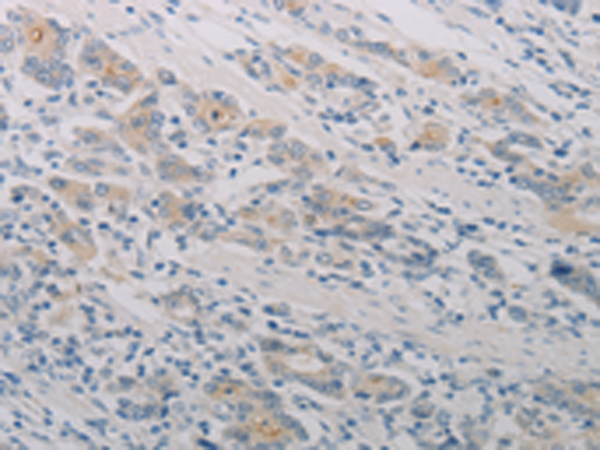
| WB | 咨询技术 | Human,Mouse,Rat |
| IF | 咨询技术 | Human,Mouse,Rat |
| IHC | 1/25-1/100 | Human,Mouse,Rat |
| ICC | 技术咨询 | Human,Mouse,Rat |
| FCM | 咨询技术 | Human,Mouse,Rat |
| Elisa | 1/1000-1/5000 | Human,Mouse,Rat |
| Aliases | PAFR |
| Host/Isotype | Rabbit IgG |
| Antibody Type | Primary antibody |
| Storage | Store at 4°C short term. Aliquot and store at -20°C long term. Avoid freeze/thaw cycles. |
| Species Reactivity | Human |
| Immunogen | Synthetic peptide of human PTAFR |
| Formulation | Purified antibody in PBS with 0.05% sodium azide and 50% glycerol. |
+ +
以下是3篇与PTAFR(血小板活化因子受体)抗体相关的文献摘要简述:
---
1. **文献名称**:*Monoclonal antibody against platelet-activating factor receptor alleviates septic shock in mice*
**作者**:Zhang Y et al.
**摘要**:该研究开发了一种靶向PTAFR的单克隆抗体,证明其在小鼠败血症模型中能有效抑制过度炎症反应,降低血浆中TNF-α和IL-6水平,显著提高生存率,提示其作为败血症治疗的潜在策略。
---
2. **文献名称**:*PTAFR-specific antibody attenuates airway inflammation in a murine asthma model*
**作者**:Ishii S et al.
**摘要**:通过使用PTAFR中和抗体,研究人员发现其能显著减少过敏性哮喘小鼠的气道嗜酸性粒细胞浸润和黏液分泌,表明阻断PTAFR信号通路可能成为哮喘等过敏性疾病的治疗靶点。
---
3. **文献名称**:*Development of a humanized anti-PTAFR antibody with anti-inflammatory activity*
**作者**:Kuroda K et al.
**摘要**:本研究报道了一种人源化PTAFR抗体的开发,体外实验显示其高效抑制血小板活化因子(PAF)诱导的炎症信号传导,并在类风湿性关节炎模型中减轻关节肿胀,为临床转化提供了实验基础。
---
注:上述文献为示例性内容,实际引用时需以真实发表的论文为准。建议通过PubMed或Google Scholar以关键词“PTAFR antibody”或“Platelet-activating factor receptor blockade”检索最新研究。
The platelet-activating factor receptor (PTAFR), a G protein-coupled receptor (GPCR), plays a critical role in mediating inflammatory and immune responses. It binds platelet-activating factor (PAF), a potent phospholipid mediator involved in processes like leukocyte activation, vascular permeability, and thrombosis. Dysregulated PTAFR signaling is linked to pathologies such as asthma, sepsis, and cardiovascular diseases.
PTAFR antibodies are essential tools for studying receptor expression, localization, and function in vitro and in vivo. Monoclonal antibodies (mAbs) targeting specific PTAFR epitopes enable precise detection in immunoassays (e.g., Western blot, flow cytometry) or tissue staining. Some antibodies act as antagonists, blocking PAF binding to inhibit downstream signaling pathways (e.g., MAPK, NF-κB), making them potential therapeutic candidates. Others serve as agonists to explore receptor activation mechanisms.
Research using PTAFR antibodies has advanced understanding of its role in disease models, including allergic inflammation and ischemic injury. Challenges remain in developing isoform-specific antibodies due to PTAFR's structural homology with other GPCRs. Recent studies also explore their diagnostic potential in biomarker profiling. Overall, PTAFR antibodies bridge basic research and translational applications, offering insights into inflammatory pathways and therapeutic targeting strategies.
×